Yulei Qin
Learn the Ropes, Then Trust the Wins: Self-imitation with Progressive Exploration for Agentic Reinforcement Learning
Sep 26, 2025
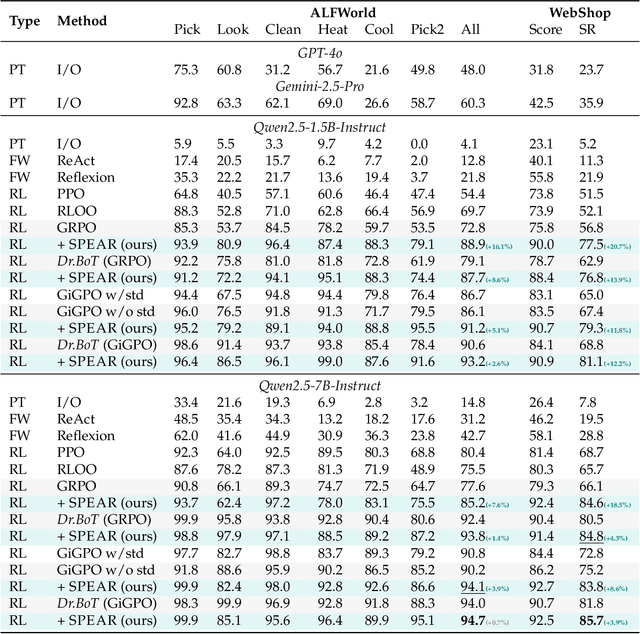
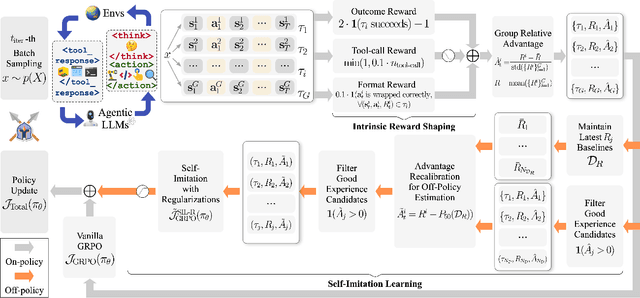
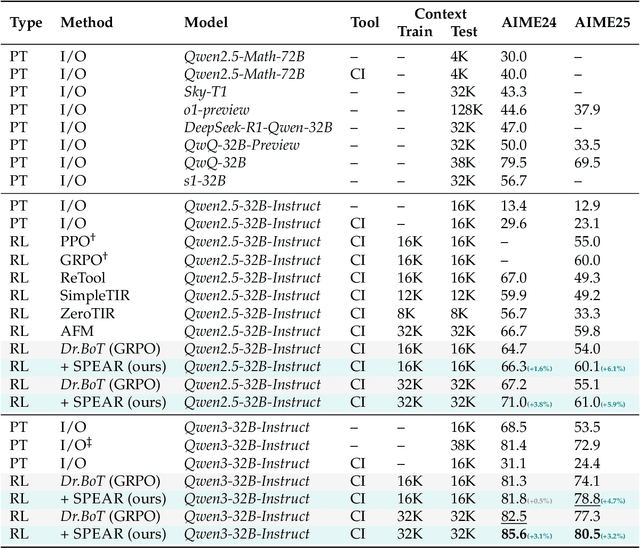
Abstract:Reinforcement learning (RL) is the dominant paradigm for sharpening strategic tool use capabilities of LLMs on long-horizon, sparsely-rewarded agent tasks, yet it faces a fundamental challenge of exploration-exploitation trade-off. Existing studies stimulate exploration through the lens of policy entropy, but such mechanical entropy maximization is prone to RL training instability due to the multi-turn distribution shifting. In this paper, we target the progressive exploration-exploitation balance under the guidance of the agent own experiences without succumbing to either entropy collapsing or runaway divergence. We propose SPEAR, a curriculum-based self-imitation learning (SIL) recipe for training agentic LLMs. It extends the vanilla SIL framework, where a replay buffer stores self-generated promising trajectories for off-policy update, by gradually steering the policy evolution within a well-balanced range of entropy across stages. Specifically, our approach incorporates a curriculum to manage the exploration process, utilizing intrinsic rewards to foster skill-level exploration and facilitating action-level exploration through SIL. At first, the auxiliary tool call reward plays a critical role in the accumulation of tool-use skills, enabling broad exposure to the unfamiliar distributions of the environment feedback with an upward entropy trend. As training progresses, self-imitation gets strengthened to exploit existing successful patterns from replayed experiences for comparative action-level exploration, accelerating solution iteration without unbounded entropy growth. To further stabilize training, we recalibrate the advantages of experiences in the replay buffer to address the potential policy drift. Reugularizations such as the clipping of tokens with high covariance between probability and advantage are introduced to the trajectory-level entropy control to curb over-confidence.
Multi-Level Optimal Transport for Universal Cross-Tokenizer Knowledge Distillation on Language Models
Dec 19, 2024Abstract:Knowledge distillation (KD) has become a prevalent technique for compressing large language models (LLMs). Existing KD methods are constrained by the need for identical tokenizers (i.e., vocabularies) between teacher and student models, limiting their versatility in handling LLMs of different architecture families. In this paper, we introduce the Multi-Level Optimal Transport (MultiLevelOT), a novel approach that advances the optimal transport for universal cross-tokenizer knowledge distillation. Our method aligns the logit distributions of the teacher and the student at both token and sequence levels using diverse cost matrices, eliminating the need for dimensional or token-by-token correspondence. At the token level, MultiLevelOT integrates both global and local information by jointly optimizing all tokens within a sequence to enhance robustness. At the sequence level, we efficiently capture complex distribution structures of logits via the Sinkhorn distance, which approximates the Wasserstein distance for divergence measures. Extensive experiments on tasks such as extractive QA, generative QA, and summarization demonstrate that the MultiLevelOT outperforms state-of-the-art cross-tokenizer KD methods under various settings. Our approach is robust to different student and teacher models across model families, architectures, and parameter sizes.
Leveraging Open Knowledge for Advancing Task Expertise in Large Language Models
Aug 28, 2024



Abstract:The cultivation of expertise for large language models (LLMs) to solve tasks of specific areas often requires special-purpose tuning with calibrated behaviors on the expected stable outputs. To avoid huge cost brought by manual preparation of instruction datasets and training resources up to hundreds of hours, the exploitation of open knowledge including a wealth of low rank adaptation (LoRA) models and instruction datasets serves as a good starting point. However, existing methods on model and data selection focus on the performance of general-purpose capabilities while neglecting the knowledge gap exposed in domain-specific deployment. In the present study, we propose to bridge such gap by introducing few human-annotated samples (i.e., K-shot) for advancing task expertise of LLMs with open knowledge. Specifically, we develop an efficient and scalable pipeline to cost-efficiently produce task experts where K-shot data intervene in selecting the most promising expert candidates and the task-relevant instructions. A mixture-of-expert (MoE) system is built to make the best use of individual-yet-complementary knowledge between multiple experts. We unveil the two keys to the success of a MoE system, 1) the abidance by K-shot, and 2) the insistence on diversity. For the former, we ensure that models that truly possess problem-solving abilities on K-shot are selected rather than those blind guessers. Besides, during data selection, instructions that share task-relevant contexts with K-shot are prioritized. For the latter, we highlight the diversity of constituting experts and that of the fine-tuning instructions throughout the model and data selection process. Extensive experimental results confirm the superiority of our approach over existing methods on utilization of open knowledge across various tasks. Codes and models will be released later.
Unleashing the Power of Data Tsunami: A Comprehensive Survey on Data Assessment and Selection for Instruction Tuning of Language Models
Aug 07, 2024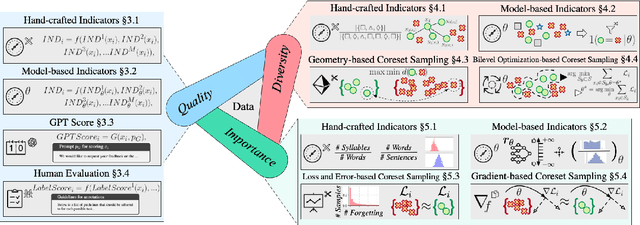
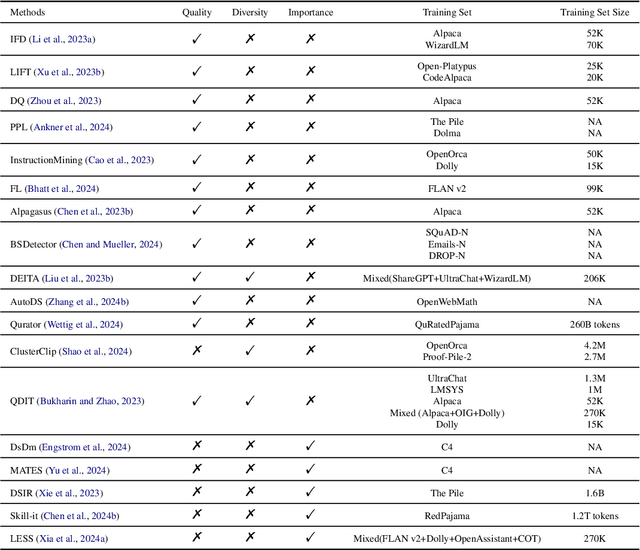
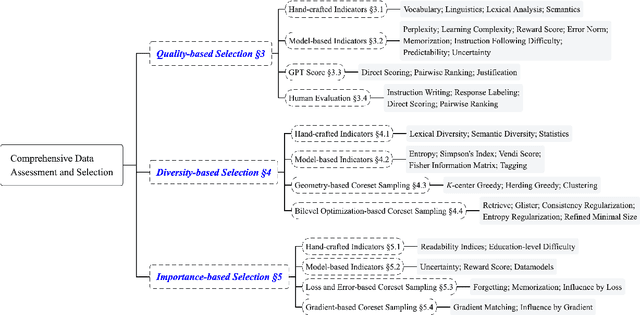
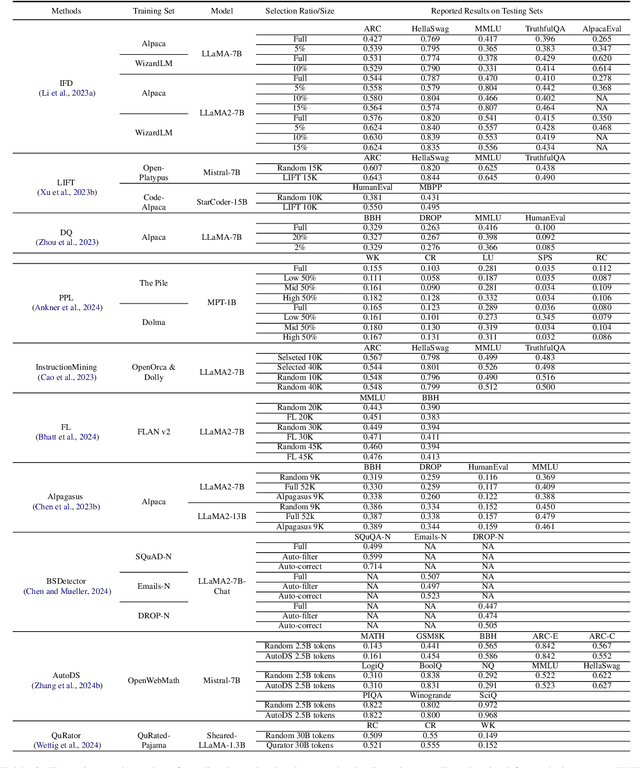
Abstract:Instruction tuning plays a critical role in aligning large language models (LLMs) with human preference. Despite the vast amount of open instruction datasets, naively training a LLM on all existing instructions may not be optimal and practical. To pinpoint the most beneficial datapoints, data assessment and selection methods have been proposed in the fields of natural language processing (NLP) and deep learning. However, under the context of instruction tuning, there still exists a gap in knowledge on what kind of data evaluation metrics can be employed and how they can be integrated into the selection mechanism. To bridge this gap, we present a comprehensive review on existing literature of data assessment and selection especially for instruction tuning of LLMs. We systematically categorize all applicable methods into quality-based, diversity-based, and importance-based ones where a unified, fine-grained taxonomy is structured. For each category, representative methods are elaborated to describe the landscape of relevant research. In addition, comparison between latest methods is conducted on their officially reported results to provide in-depth discussions on their limitations. Finally, we summarize the open challenges and propose the promosing avenues for future studies. All related contents are available at https://github.com/yuleiqin/fantastic-data-engineering.
RESTORE: Towards Feature Shift for Vision-Language Prompt Learning
Mar 10, 2024



Abstract:Prompt learning is effective for fine-tuning foundation models to improve their generalization across a variety of downstream tasks. However, the prompts that are independently optimized along a single modality path, may sacrifice the vision-language alignment of pre-trained models in return for improved performance on specific tasks and classes, leading to poorer generalization. In this paper, we first demonstrate that prompt tuning along only one single branch of CLIP (e.g., language or vision) is the reason why the misalignment occurs. Without proper regularization across the learnable parameters in different modalities, prompt learning violates the original pre-training constraints inherent in the two-tower architecture. To address such misalignment, we first propose feature shift, which is defined as the variation of embeddings after introducing the learned prompts, to serve as an explanatory tool. We dive into its relation with generalizability and thereafter propose RESTORE, a multi-modal prompt learning method that exerts explicit constraints on cross-modal consistency. To be more specific, to prevent feature misalignment, a feature shift consistency is introduced to synchronize inter-modal feature shifts by measuring and regularizing the magnitude of discrepancy during prompt tuning. In addition, we propose a "surgery" block to avoid short-cut hacking, where cross-modal misalignment can still be severe if the feature shift of each modality varies drastically at the same rate. It is implemented as feed-forward adapters upon both modalities to alleviate the misalignment problem. Extensive experiments on 15 datasets demonstrate that our method outperforms the state-of-the-art prompt tuning methods without compromising feature alignment.
Sinkhorn Distance Minimization for Knowledge Distillation
Feb 27, 2024Abstract:Knowledge distillation (KD) has been widely adopted to compress large language models (LLMs). Existing KD methods investigate various divergence measures including the Kullback-Leibler (KL), reverse Kullback-Leibler (RKL), and Jensen-Shannon (JS) divergences. However, due to limitations inherent in their assumptions and definitions, these measures fail to deliver effective supervision when few distribution overlap exists between the teacher and the student. In this paper, we show that the aforementioned KL, RKL, and JS divergences respectively suffer from issues of mode-averaging, mode-collapsing, and mode-underestimation, which deteriorates logits-based KD for diverse NLP tasks. We propose the Sinkhorn Knowledge Distillation (SinKD) that exploits the Sinkhorn distance to ensure a nuanced and precise assessment of the disparity between teacher and student distributions. Besides, profit by properties of the Sinkhorn metric, we can get rid of sample-wise KD that restricts the perception of divergence in each teacher-student sample pair. Instead, we propose a batch-wise reformulation to capture geometric intricacies of distributions across samples in the high-dimensional space. Comprehensive evaluation on GLUE and SuperGLUE, in terms of comparability, validity, and generalizability, highlights our superiority over state-of-the-art methods on all kinds of LLMs with encoder-only, encoder-decoder, and decoder-only architectures.
Towards Robust Text Retrieval with Progressive Learning
Nov 20, 2023



Abstract:Retrieval augmentation has become an effective solution to empower large language models (LLMs) with external and verified knowledge sources from the database, which overcomes the limitations and hallucinations of LLMs in handling up-to-date and domain-specific information. However, existing embedding models for text retrieval usually have three non-negligible limitations. First, the number and diversity of samples in a batch are too restricted to supervise the modeling of textual nuances at scale. Second, the high proportional noise are detrimental to the semantic correctness and consistency of embeddings. Third, the equal treatment to easy and difficult samples would cause sub-optimum convergence of embeddings with poorer generalization. In this paper, we propose the PEG, a progressively learned embeddings for robust text retrieval. Specifically, we increase the training in-batch negative samples to 80,000, and for each query, we extracted five hard negatives. Concurrently, we incorporated a progressive learning mechanism, enabling the model to dynamically modulate its attention to the samples throughout the entire training process. Additionally, PEG is trained on more than 100 million data, encompassing a wide range of domains (e.g., finance, medicine, and tourism) and covering various tasks (e.g., question-answering, machine reading comprehension, and similarity matching). Extensive experiments conducted on C-MTEB and DuReader demonstrate that PEG surpasses state-of-the-art embeddings in retrieving true positives, highlighting its significant potential for applications in LLMs. Our model is publicly available at https://huggingface.co/TownsWu/PEG.
CAPro: Webly Supervised Learning with Cross-Modality Aligned Prototypes
Oct 15, 2023



Abstract:Webly supervised learning has attracted increasing attention for its effectiveness in exploring publicly accessible data at scale without manual annotation. However, most existing methods of learning with web datasets are faced with challenges from label noise, and they have limited assumptions on clean samples under various noise. For instance, web images retrieved with queries of tiger cat (a cat species) and drumstick (a musical instrument) are almost dominated by images of tigers and chickens, which exacerbates the challenge of fine-grained visual concept learning. In this case, exploiting both web images and their associated texts is a requisite solution to combat real-world noise. In this paper, we propose Cross-modality Aligned Prototypes (CAPro), a unified prototypical contrastive learning framework to learn visual representations with correct semantics. For one thing, we leverage textual prototypes, which stem from the distinct concept definition of classes, to select clean images by text matching and thus disambiguate the formation of visual prototypes. For another, to handle missing and mismatched noisy texts, we resort to the visual feature space to complete and enhance individual texts and thereafter improve text matching. Such semantically aligned visual prototypes are further polished up with high-quality samples, and engaged in both cluster regularization and noise removal. Besides, we propose collective bootstrapping to encourage smoother and wiser label reference from appearance-similar instances in a manner of dictionary look-up. Extensive experiments on WebVision1k and NUS-WIDE (Web) demonstrate that CAPro well handles realistic noise under both single-label and multi-label scenarios. CAPro achieves new state-of-the-art performance and exhibits robustness to open-set recognition. Codes are available at https://github.com/yuleiqin/capro.
MME: A Comprehensive Evaluation Benchmark for Multimodal Large Language Models
Jul 02, 2023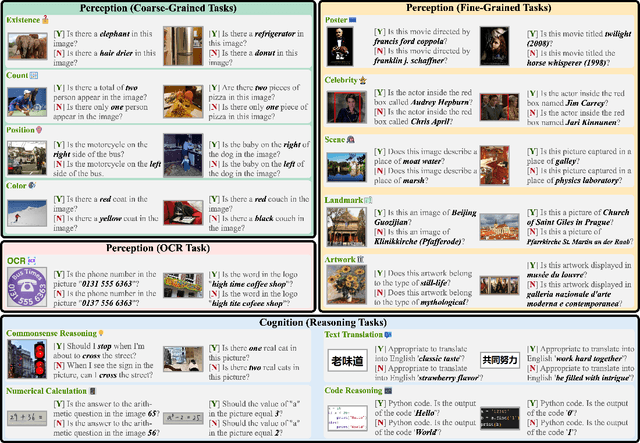
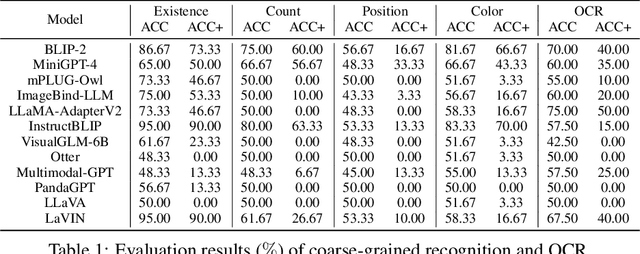
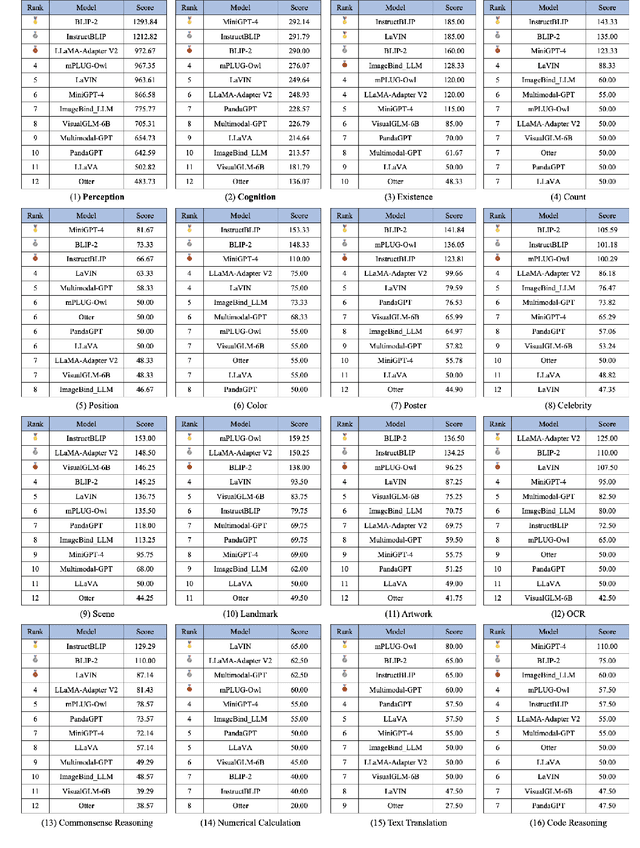
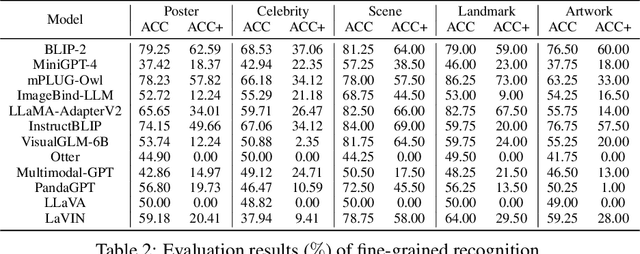
Abstract:Multimodal Large Language Model (MLLM) relies on the powerful LLM to perform multimodal tasks, showing amazing emergent abilities in recent studies, such as writing poems based on an image. However, it is difficult for these case studies to fully reflect the performance of MLLM, lacking a comprehensive evaluation. In this paper, we fill in this blank, presenting the first MLLM Evaluation benchmark MME. It measures both perception and cognition abilities on a total of 14 subtasks. In order to avoid data leakage that may arise from direct use of public datasets for evaluation, the annotations of instruction-answer pairs are all manually designed. The concise instruction design allows us to fairly compare MLLMs, instead of struggling in prompt engineering. Besides, with such an instruction, we can also easily carry out quantitative statistics. A total of 12 advanced MLLMs are comprehensively evaluated on our MME, which not only suggests that existing MLLMs still have a large room for improvement, but also reveals the potential directions for the subsequent model optimization.
Multi-site, Multi-domain Airway Tree Modeling : A Public Benchmark for Pulmonary Airway Segmentation
Mar 10, 2023



Abstract:Open international challenges are becoming the de facto standard for assessing computer vision and image analysis algorithms. In recent years, new methods have extended the reach of pulmonary airway segmentation that is closer to the limit of image resolution. Since EXACT'09 pulmonary airway segmentation, limited effort has been directed to quantitative comparison of newly emerged algorithms driven by the maturity of deep learning based approaches and clinical drive for resolving finer details of distal airways for early intervention of pulmonary diseases. Thus far, public annotated datasets are extremely limited, hindering the development of data-driven methods and detailed performance evaluation of new algorithms. To provide a benchmark for the medical imaging community, we organized the Multi-site, Multi-domain Airway Tree Modeling (ATM'22), which was held as an official challenge event during the MICCAI 2022 conference. ATM'22 provides large-scale CT scans with detailed pulmonary airway annotation, including 500 CT scans (300 for training, 50 for validation, and 150 for testing). The dataset was collected from different sites and it further included a portion of noisy COVID-19 CTs with ground-glass opacity and consolidation. Twenty-three teams participated in the entire phase of the challenge and the algorithms for the top ten teams are reviewed in this paper. Quantitative and qualitative results revealed that deep learning models embedded with the topological continuity enhancement achieved superior performance in general. ATM'22 challenge holds as an open-call design, the training data and the gold standard evaluation are available upon successful registration via its homepage.
 Add to Chrome
Add to Chrome Add to Firefox
Add to Firefox Add to Edge
Add to Edge